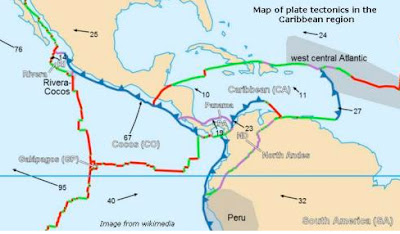Was the
Isthmus of Panama once submerged and did the Pacific Ocean have a seaway
through to the Atlantic Ocean?
A Central
American Seaway allowed for a warm, salty water inflow from the Caribbean to
the Pacific, and a cool, low-salinity water outflow from the Pacific to the
Caribbean
It is claimed by Manuel A. Iturralde-Vinent, of the
National Museum of Natural History in Cuba, that in
order to summarize the evolution of the Caribbean Seaway, this is presented to
illustrate the history of topographic barriers between North and South America,
and their bearing on the history of marine flow across the area. This Seaway is
here understood as a truly oceanic basin located between the North and South
American continental landmasses. This seaway represents a linkage between the Pacific
and the Atlantic Oceans.
Also
according to Michael Xavier Kirby, of the Center for Tropical Paleoecology and
Archaeology, Smithsonian Tropical Research Institute, and Douglas S. Jones and
Bruce J. MacFadden of the University of Florida, the palaeogeography of Central
America has changed profoundly…from a volcanic arc separated from South America
by a wide seaway, to an isthmus that connected North and South America. The
formation of the Isthmus of Panama was important because it allowed the mixing
of terrestrial faunas between the two continents, as well as physically
separating a once continuous marine province into separate and distinct Pacific
and Caribbean communities. The formation of the Isthmus of Panama also
ultimately led to profound changes in global climate by strengthening the Gulf
Stream and thermohaline downwelling in the North Atlantic.
And according
to Daniela N. Schmidt of the Department of Geology, Royal Holloway University
of London and Department of Earth Sciences, University of Bristol, in her work The closure history of the Central American
seaway: evidence from isotopes and fossils to models and molecules, the rise of the Panama
Isthmus was the last step in the closure of the circumtropical seaways. The closure of the Panama Isthmus had
fundamental consequences for global ocean circulation, evolution of the
tropical ecosystems and potentially influenced the switch to the modern ‘cold
house’ climate mode. The Atlantic and Pacific marine ecosystems became gradually
separated whereas terrestrial organisms suddenly had the means to migrate
between North and South America. Combining high-resolution geochemical proxies for the closure history with data on fossil distributions and genetic data provides independent evidence on the closure history. These datasets provide new boundary conditions for Earth System models to simulate the effects of palaeoceanographic change on global
climate and allow exploration of hypotheses for the Northern Hemisphere glaciation.
In addition,
according to Hermann Duque-Caro, in his 1990 Stratigraphy paleoceanography and paleobiography in northwest South
America in the evolution of the Panama Seaway, "Today, the Panama Isthmus
blocks the flow of Pacific waters into the Atlantic. When this land bridge was
submerged, Central America consisted of a complex island-arc archipelago
peninsula with several marine corridors and basins. During the initial uplift
of the Panama sill to upper middle bathyal depths, and subsequent blocking of
the deep-water flow through the seaway, changed bottom-water circulation and
sedimentation in the coastal areas of Central America as discovered by the deep
sea drilling mentioned in the last post.
Map
of plate techtonics in the Caribbean Region. Their movement was responsible
for the closing of the Central American Seaway
According to
Matthew E. Kirby, Department of Geological Sciences, Cal State University, as part
of the Central American volcanic arc, the Panama microplate formed through
subduction of various oceanic microplates that lie between the Cocos and Nazca
plates to the south, the Caribbean plate to the north and the South American
plate to the east (note the tectonic plate map above).
The
Atrato Seaway between the Pacific Ocean and the Atlantic Ocean through the
Panama Canal Basin as described by Kirby and MacFadden, often referred to as
the CAS (Central American Seaway), claimed by Duque-Caro to have been at least
500 feet deep
The closing
of the Central American Seaway changed the boundary conditions of the oceans
and created a state of the oceanic and atmospheric system. With the rising of
the isthmus, it blocked the exchange of tropical water masses between the
Atlantic and the Pacific and triggered, or strengthened, the North Atlantic deep
water production, initiated the Caribbean Current, strengthened the Gulf
Stream, and therefore changed the global distribution of deep water masses and
heat salinity, which intensified the circulation causing the buildup of
sediment drifts in the Caribbean and deepened the Barnes-Apure Basin in the
basement of Guiana, along the northern Barinas-Apure Basin of Venezuela, and
the Llanos Basin of Colombia, and later in the North Atlantic.
With the closing of the Central American
Seaway, there was a cutoff of the inflow and outflow between the two oceans,
and a strong northward flow of warm, salty water with more heat released out of
the north into the atmosphere
The existence of this Atrato Seaway (Central American Seaway) did not, however, as these
studies verify, change the water circulation in the South Pacific and
along the South American west coast. Though it likely resulted in the central
Pacific counter-current flowing into the Caribbean.








No comments:
Post a Comment